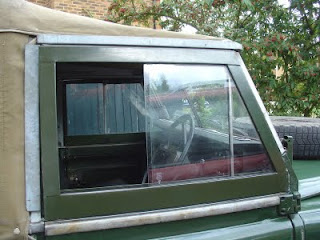The speed claims about 97 000miles but this might only represent the chassis, however, a rebuild did take place 2 years ago. I can confirm that this is the 3rd engine as the vehicle documentation needed changing, plus the original engine it came with when I bought it seized a month ago. The new engine is an ebay special so no idea on mileage but based on the engine number it was no. 305 of the Land Rover Factory floor.
The 88" looking bare without its canvas roof - but in this mode, it's a great vehicle to drive in the summer.
First up, are the hoops. They slot into the rear bin and have a retaining nut and bolt to keep them in place.
Next up are the door frames, which are connected to the hoops. The door frames have a runner for the canvas to fit.
And finally the canvas roof. The top of the front windscreen has hoops for the roof to connect to. The canvas is held in place via a number of internal straps.

The rear of the Land Rover. I have fitted a fume curtain which should assist with retaining the heat in the front cabin. On that note, the heat is generated via the water cooling system as its heated through the engine. Fresh air is sucked through a vent on the left side of the engine. The heat varies depending on the running temperature of the engine. i.e. only once the engine is warm does the heater work.

Fitting the door windows comes next. It's an easy job to do as only two nuts hold the top in place.
And finally the job is done. Not quite your modified Land Rover for overland travel but decades ago, this was one of the few options available.
Here are a few Series Land Rovers kitted for overland travel:






No comments:
Post a Comment
Comments always welcome...